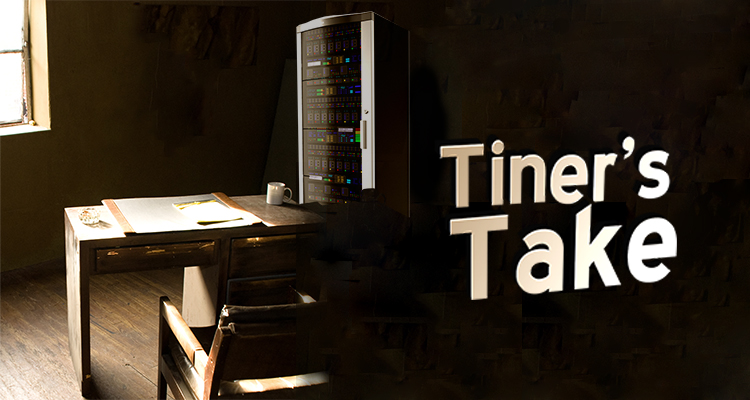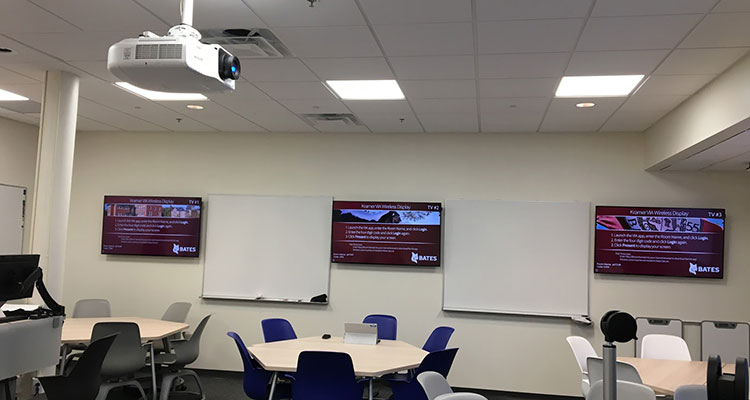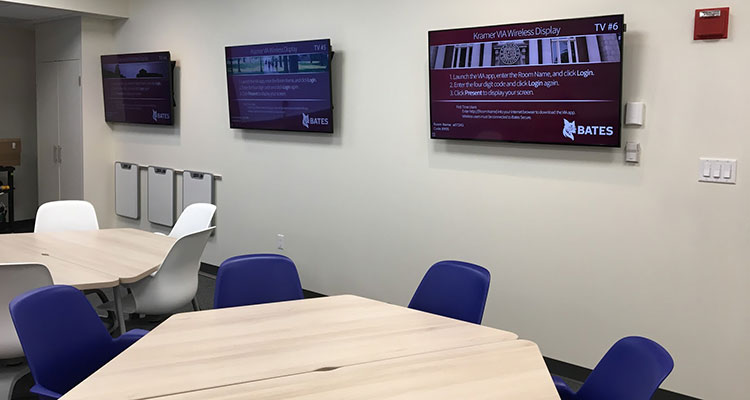A Thoughtful Approach to Active Learning
 Active learning has been on the rise in American college classrooms over the past several years. In general, active learning usually takes place in a classroom that is designed for more group work and discussion and less lecturing from the front of the room. There are dozens of varieties of active learning, and most furniture and AV manufacturers have been trying to get into the growing market.
Active learning has been on the rise in American college classrooms over the past several years. In general, active learning usually takes place in a classroom that is designed for more group work and discussion and less lecturing from the front of the room. There are dozens of varieties of active learning, and most furniture and AV manufacturers have been trying to get into the growing market.
At Bates College, we have carefully approached active learning. Over the past few years, we have had guest speakers from other colleges who practice active learning, we have had consultants come in a look at space and (most importantly) we have had faculty who have told us what they are looking for in an active classroom. Last winter several of us participated in writing a grant to renovate a classroom and make it an active learning space. Fortunately, we were awarded the grant and over the summer the room was completed.
 I will get to the technology in the room in a moment, but first I think it is important to recognize how we approached the design of the room, and how faculty were assigned to teach in it. The room we renovated was a tiered classroom, that sat about 40 students. Due to the size of the room, the fact that it had no external walls and that it was tiered made it rather unpopular with instructors. This was key to choosing a room. We did not want to take a room that people felt was already functioning well and force a re-design. Our second decision was that faculty would not be randomly assigned to the room, but rather, they would have to request it. This would allow us to design a room that was really different and no one would be forced to adapt to it. Rather, faculty would WANT to adapt to it. This is an important key for any integrators or designers who are putting together active classrooms. Make sure you understand how the institution is going to use the room. Make sure you know how the faculty intend on using the room. Design your space from that knowledge, rather than from what you did in the last install, or what may be the most profitable for you.
I will get to the technology in the room in a moment, but first I think it is important to recognize how we approached the design of the room, and how faculty were assigned to teach in it. The room we renovated was a tiered classroom, that sat about 40 students. Due to the size of the room, the fact that it had no external walls and that it was tiered made it rather unpopular with instructors. This was key to choosing a room. We did not want to take a room that people felt was already functioning well and force a re-design. Our second decision was that faculty would not be randomly assigned to the room, but rather, they would have to request it. This would allow us to design a room that was really different and no one would be forced to adapt to it. Rather, faculty would WANT to adapt to it. This is an important key for any integrators or designers who are putting together active classrooms. Make sure you understand how the institution is going to use the room. Make sure you know how the faculty intend on using the room. Design your space from that knowledge, rather than from what you did in the last install, or what may be the most profitable for you.
 Our room has a significant amount of technology in it, as many active classrooms do. Our designer (our own Senior AV Analyst Ben Lizzotte) was very careful not to make the room ABOUT technology. The technology is there to enhance what is happening in the room, not to dictate what happens in the room. The room has six televisions to pair up with the six octagonal tables in the room. In our rack are six corresponding Kramer VIA devices. Students are able to connect to the VIA’s with any device they chose and project that content onto any, or all, of the monitors. The classroom lectern houses a Crestron touchpanel that also doubles as the computer monitor. The computer is located in the rack, so that the lectern can maintain its small size. Over the podium is a ceiling mounted document camera. There are two cameras in the room, one for web conferencing and another for classroom capture. Finally, several microphones are in the ceiling to tie in with the previously mentioned uses. One sticking point in our initial discussions about the room was whether there would be a projector. Several felt that a projector would cause instructors to fall back to the “front of the room” lecture. However, after listening to our faculty, it was clear that there are times that a front to the room is needed. This may be to watch a video clip or to watch presentations from students.
Our room has a significant amount of technology in it, as many active classrooms do. Our designer (our own Senior AV Analyst Ben Lizzotte) was very careful not to make the room ABOUT technology. The technology is there to enhance what is happening in the room, not to dictate what happens in the room. The room has six televisions to pair up with the six octagonal tables in the room. In our rack are six corresponding Kramer VIA devices. Students are able to connect to the VIA’s with any device they chose and project that content onto any, or all, of the monitors. The classroom lectern houses a Crestron touchpanel that also doubles as the computer monitor. The computer is located in the rack, so that the lectern can maintain its small size. Over the podium is a ceiling mounted document camera. There are two cameras in the room, one for web conferencing and another for classroom capture. Finally, several microphones are in the ceiling to tie in with the previously mentioned uses. One sticking point in our initial discussions about the room was whether there would be a projector. Several felt that a projector would cause instructors to fall back to the “front of the room” lecture. However, after listening to our faculty, it was clear that there are times that a front to the room is needed. This may be to watch a video clip or to watch presentations from students.
Due to the very flexible technology design the room can be used any way a faculty member, or other users choose. The only technology that sits on the floor of the classroom is the small lectern. This can be easily moved by disconnecting a couple of CAT5 cables and a power cord. This is important for our users, because too often we have seen rooms designed to be flexible. Unfortunately, this “flexibility” often takes several minutes in order to achieve and may not work. That is, we can not expect faculty or students to spend 10 minutes at the beginning of any class, rearranging the room, moving portable walls, or rolling technology in or out of the room.
 In the first several weeks of the use of the room, the feedback has been excellent. Because the work was paid for with a grant, we have been purposeful in collecting data from faculty and students about the room. Interestingly, some of the students were initially apprehensive about the room. This was the first time for them to walk into a space that did not look like your typical lecture or seminar room. It took some time to understand that they had an active role in this setting. The faculty were very interested in exploring how to use the room and technology. One interesting thing that we noted immediately is that the students preferred using the monitors near their table, over the central projector, when they needed to view common information.
In the first several weeks of the use of the room, the feedback has been excellent. Because the work was paid for with a grant, we have been purposeful in collecting data from faculty and students about the room. Interestingly, some of the students were initially apprehensive about the room. This was the first time for them to walk into a space that did not look like your typical lecture or seminar room. It took some time to understand that they had an active role in this setting. The faculty were very interested in exploring how to use the room and technology. One interesting thing that we noted immediately is that the students preferred using the monitors near their table, over the central projector, when they needed to view common information.
Data collection is an area where integrators and designers could also assist and provide services. Even if installs are not grant funded, schools are using data more than ever. Being able to understand what students and faculty thought of the spaces, along with how and if the room improved learning, is a critical piece of knowing whether to install more rooms to allow for active learning. This is where the integrators could provide value, after having been involved in several other installations. A well vetted data collection method would help us understand how the room compares to what other schools have done.
Through the process we learned the valuable lesson that moving carefully and thoughtfully can produce an excellent result. Most importantly, listening to the people who will use the space, before design, during design and after installation is critical to fulfilling their desires for the space. Listening to what others have done is also important, but you need to design for the cultures and uniqueness of your institution.




